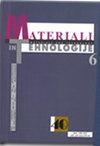合金元素和表面性能对高温沉积wc涂层腐蚀行为的影响
IF 0.8
4区 材料科学
Q4 MATERIALS SCIENCE, MULTIDISCIPLINARY
引用次数: 0
摘要
本研究的主要目的是研究镍铝缓冲液和碳化钨基陶瓷-金属复合涂层材料在石化工业应用的EN 1.4404质量不锈钢上在硫酸(H2SO4)环境中的腐蚀行为。为此,使用HVOF(高速氧燃料)技术在镍铝沉积的1.4404不锈钢衬底上制备了碳化钨基涂层。在涂层的表征中,采用x射线衍射(XRD)进行物相分析,光学显微镜和扫描电镜(SEM)进行表面形貌分析,图像分析仪进行涂层厚度测量,能谱分析仪进行元素分析,粗糙度仪进行表面结构分析。在涂层中观察到WC、Co、Ni和nial基相。金相研究表明,各涂层具有相似的涂层组织,且与基体接触良好。利用恒电位器/恒流器进行了动电位极化测量和腐蚀试验,以确定HVOF等离子喷涂涂层的腐蚀行为。结果表明,与NiAl和WCNi-NiAl样品相比,wccco -NiAl涂层的不锈钢基体具有更高的耐H2SO4腐蚀性能。本文章由计算机程序翻译,如有差异,请以英文原文为准。
EFFECTS OF ALLOYING ELEMENTS AND SURFACE PROPERTIES ON THE CORROSION BEHAVIOR OF HVOF-DEPOSITED WC COATINGS
The main purpose of this study is to investigate the corrosion behavior of nickel-aluminum buffer and tungsten-carbide-based ceramic-metal composite coated materials on EN 1.4404 quality stainless steels in a sulfuric acid (H2SO4) environment for petrochemical industry applications. For this purpose, tungsten-carbide-based coatings were produced on nickel-aluminum-deposited 1.4404 stainless-steel substrates using the HVOF (High Velocity Oxy-Fuel) technique. In the characterization of coatings, X-ray diffraction (XRD) for phase analysis, optical microscope and scanning electron microscope (SEM) for surface morphology, image analyzer for coating thickness measurements, energy distribution spectroscopy (EDS) for elemental analysis, and roughness device for surface structures, were used. WC-, Co-, Ni-, and NiAl-based phases were observed in the coatings. According to metallographic studies, all the coatings had a similar coating microstructure and made good contact with the substrate. Potentiodynamic polarization measurements and corrosion tests were carried out to determine the corrosion behavior of HVOF plasma-sprayed coatings using a potentiostat/galvanostat. The results showed that the WCCo-NiAl-coated stainless-steel substrate had a higher corrosion resistance to the H2SO4 environment than the NiAl and WCNi-NiAl samples.
求助全文
通过发布文献求助,成功后即可免费获取论文全文。
去求助
来源期刊

Materiali in tehnologije
工程技术-材料科学:综合
CiteScore
1.30
自引率
0.00%
发文量
73
审稿时长
4-8 weeks
期刊介绍:
The journal MATERIALI IN TEHNOLOGIJE/MATERIALS AND TECHNOLOGY is a scientific journal, devoted to original papers and review scientific papers concerned with the areas of fundamental and applied science and technology. Topics of particular interest include metallic materials, inorganic materials, polymers, vacuum technique and lately nanomaterials.
 求助内容:
求助内容: 应助结果提醒方式:
应助结果提醒方式:


